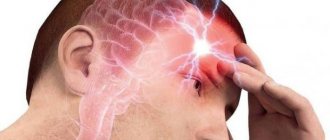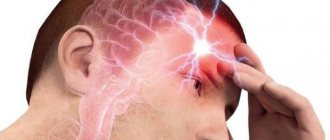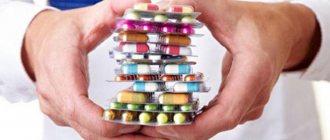Doctors Cost
Price list Doctors clinic
Vegetovascular dystonia (VSD) is now called by doctors somatoform dysfunction of the autonomic nervous system. This is a common disease that affects women 2 times more often than men. VSD is just a syndrome, but it must be taken into account when prescribing treatment for the underlying disease. To talk about pathology, let’s remember how the human nervous system works.
Table 1. Human nervous system - simplified diagram
| Nervous system. | Somatic. Responsible for the work of skeletal muscles. A person can control it. | |
| Vegetative. Responsible for the functioning of internal organs. Does not submit to willpower. | Sympathetic. Strengthens the activity of the heart, constricts blood vessels, increases blood pressure. | |
| Parasympathetic. Relaxes heart rate, dilates blood vessels, reduces blood pressure. | ||
The autonomic nervous system has a central and peripheral division. Its representations are in the cerebral cortex, brainstem, hypothalamus, and spinal cord. The peripheral section is represented by ganglia and nerve plexuses. If there are disturbances in any of these departments, symptoms of VSD appear.
Causes
Vegetative-vascular dystonia in most cases is a secondary pathology that complicates existing somatic and neurological diseases, but requires mandatory treatment. There are causative and provoking factors for its development.
Table 2. Types and causes of VSD
| Factors | Kinds | Examples |
| Callers. | Psychogenic. | Stress. Neurosis. Depression. |
| Infectious. | Chronical bronchitis. Sluggish pyelonephritis. Encephalitis. | |
| Dishormonal. | Pregnancy. Climax. Puberty. | |
| Physical. | Radiation. Vibration. Overwork. | |
| Chemical. | Alcohol. Nicotine. Some medications. | |
| Brain lesions. | Encephalopathy. Consequences of TBI. Parkinson's disease. | |
| Somatic pathology. | Thyrotoxicosis. Diabetes. Hypertonic disease. | |
| Provoking. | Personality characteristics. | Psychovegetative reactions. |
| Constitutional predisposition. | Typical manifestations of VSD. | |
| Socio-economic prerequisites. | Low standard of living. Poor nutrition. Ultraviolet radiation deficiency. | |
| Perinatal factors. | Infections. Hypoxia. Rhesus conflict. |
Vegetative-vascular dystonia occurs as a result of a psycho-emotional reaction, its symptoms are superimposed on existing autonomic abnormalities of the human body, treatment must take this fact into account.
Manifestations
VSD is characterized by many different manifestations. Almost all body systems are affected.
- Cardiovascular. Heart rate and blood pressure change, cardiac-type pain and changes in the ECG are noted.
- Pulmonary. There is a feeling of lack of air, inhalation is impaired, blood oxygen saturation deteriorates, and paresthesia appears.
- Nervous. Worrying headaches, tinnitus, weakness, dizziness, fainting. Thinking slows down. I am tormented by fluctuations in body temperature, hyperkinesis, and episodes of depressive mood.
Table 3. Action of the sympathetic and parasympathetic systems
| Sympathetic | Parasympathetic | |
| Pupil | Extension | Narrowing |
| Salivation | Insufficient | Excessive |
| Pulse | Increased frequency | Reduction |
| Arterial pressure | Promotion | Demotion |
| Bronchial lumen | Extension | Narrowing |
| Gastric juice | Decreased secretion | Increased secretion |
| Intestinal peristalsis | Reduced | Reinforced |
| Leather | Pale | Blushed |
| Sweating | Decreased | Increased |
Kinds
Doctors distinguish the following forms of vegetative-vascular dystonia:
- according to the hypertensive type;
- hypotonic type;
- according to the cardiac type;
- mixed type.
VSD of the hypertensive type. This type of pathology is accompanied by rises in blood pressure to high values. In this regard, headache, dizziness, weakness, flashing “spots” before the eyes, and a feeling of nausea appear. VSD of the hypotonic type. A symptom of this form of pathology is a decrease in blood pressure. Difficult to diagnose due to the general nature of the manifestations. Mixed type VSD is characterized by regular changes in blood pressure from high to low values. Mixed vegetative-vascular dystonia most often appears due to a hereditary predisposition. Clinical symptoms of this form of the disease are panic attacks, increased anxiety, and irritability. VSD of the cardiac type Occurs against the background of other diseases. It manifests itself as pain in the heart area.
Expert opinion
Author:
Tatyana Aleksandrovna Kosova
Head of the Department of Rehabilitation Medicine, neurologist, reflexologist
According to the latest statistics, VSD is diagnosed in 50–70% of the population. At the same time, it is not possible to identify a pattern regarding age and gender. The onset of the disease can occur at any period of life. Among adolescents, vegetative-vascular dystonia is detected in 25–40% of cases.
VSD refers to a complex of pathological symptoms united by a common concept. Diagnosing the disease can be difficult due to the variety of clinical signs. At the Yusupov Hospital, ECG and EchoCG are prescribed for examination. In addition, MRI, CT, 24-hour Holter monitoring, EEG and laboratory tests are used. Based on the results of a comprehensive diagnosis, doctors select the correct therapy. The amount of treatment depends on the severity of symptoms. Depending on the prevailing symptoms, certain groups of drugs are prescribed.
Patients often underestimate the danger of VSD. Without treatment, the disease becomes more complicated. This worsens the patient's condition and requires serious therapy. Therefore, when the first pathological signs appear, it is recommended to consult a doctor. Timely diagnosis and quality treatment are the key to a speedy recovery.
Vascular dystonia. Symptoms and treatment
- Sympathicotonia is the predominance of the tone of the sympathetic nervous system. It is characterized by: pale skin, vasoconstriction, hypertension, tachycardia, dilated pupils, intestinal lethargy, heightened anxiety, and a feeling of fear.
- Vagotonia is the reverse state of sympathicotonia. Accompanied by redness of the skin, dilation of blood vessels, sweating, hypotension, bradycardia, constriction of the pupils, acceleration of bowel function, and irritability.
Sometimes the symptoms of VSD are mosaic; in this case, sympathetic and parasympathetic disorders are present simultaneously.
Therapy is selected individually, taking into account the main manifestations and the predominance of one or another department.
Complications
Many people do not attach importance to such a diagnosis as vegetative-vascular dystonia. This opinion is wrong. Like any disease, VSD can lead to complications. Among them:
- hypertension;
- hypotension;
- visual impairment;
- anemia;
- depression;
- weight loss;
- involuntary urination.
In this regard, doctors recommend seeking medical help when the first pathological signs appear. This will help to identify the problem in time and carry out a course of treatment.
Vegetovascular dystonia. Symptoms
Sleep disturbance.
The most common problem for people suffering from a disorder of the autonomic nervous system. There are two extremes: increased drowsiness, when you constantly want to sleep, and insomnia due to disruption of biorhythms. In both cases, sleep is superficial and it is rare to get a good night's sleep. Conventional treatment has no effect.
Instability of the psycho-emotional sphere.
As a result of insomnia, the ability to concentrate is impaired and memory decreases. A person cannot do his job efficiently. Nervous breakdowns and mood swings occur. Periods of unbridled fun are replaced by apathy, depression, and sometimes directed aggression.
Dermographism.
If you run your fingernail over the patient’s skin, a white stripe will appear in sympathotonics, and a red stripe in vagotonics. This is due to the reaction of blood vessels. In the first case they narrow, in the second they expand. This is exactly how the skin reacts to stress and sports. These features must be taken into account when engaging in physical education and sports.
Breathing disorders
appear with parasympathetic VSD. As the load on the bronchi increases, shortness of breath develops. Triggering factors include stress, physical activity, and ARVI. The well-being of patients worsens over the years, shortness of breath gives way to attacks of suffocation. Some patients develop bronchial asthma.
Meteosensitivity.
The human body reacts extremely violently to changes in atmospheric pressure, windy or rainy weather. Weakness appears, severe headaches sometimes put you to bed, and a complete lack of performance.
Digestive problems
with VSD, the symptoms are varied and opposite: increased and decreased appetite, diarrhea and constipation, abdominal pain, nausea, food selectivity. Treatment by a gastroenterologist helps little.
Disorders of the genitourinary system.
Increased or decreased urination, pain in the perineum, lower abdomen in the absence of pathology, menstrual irregularities, libido, erectile dysfunction.
Headache and dizziness
caused by impaired cerebral vascular tone. They are provoked by mental and emotional overload and stress. Sometimes fainting, tinnitus, and nausea may occur.
Table 4. Severity of VSD
| Degree | Manifestations |
| Easy. | Functionality has been preserved. The discomfort is minimal and occurs periodically. |
| Average. | Periodically, the ability to work is lost due to the occurrence of vegetative crises. |
| Heavy. | Inability to work due to persistent and long-term vegetative disorders, frequent crisis conditions. |
Diagnostic methods
Vegetative-vascular dystonia is an exception diagnosis. This means that it is placed after a complete examination of the cardiovascular and nervous systems, if no abnormalities are found in them.
For diagnosis, you need to contact a general practitioner, who, if necessary, will refer you to a cardiologist, neurologist or endocrinologist. In order for a doctor to make an accurate diagnosis, it is necessary to accurately describe the symptoms and the time of their onset. The therapist will definitely clarify whether the patient drinks alcohol, nicotine, how often he drinks coffee and what daily routine he follows. This data is necessary to correctly make recommendations for the treatment of the disease.
To diagnose vegetative-vascular dystonia, the following methods are used:
- laboratory diagnostics - general blood and urine analysis without specific changes, in biochemical analysis the lipid ratio may be disturbed;
- blood test for hormones - a study of thyroid hormones is indicative; if they increase, tachycardia and weight loss may be observed;
- ECG - changes are not typical for VSD, sometimes it is possible to record tachycardia, single extrasystoles, but there are no signs of severe conduction disturbances in the heart;
- EEG - electroencephalogram can reveal slight deviations in the conduction of impulses in the brain;
- Ultrasound of internal organs - examination of the abdominal cavity in case of complaints of indigestion, examination of the heart, kidneys, and pelvic organs in women.
Dysfunction of the nervous system is not accompanied by damage to internal organs; most indicators are within the normal range, despite complaints of poor health.
Crises with vascular dystonia. Symptoms and treatment in adults
Panic attack
– sympathoadrenal crisis. A huge amount of adrenaline is released into the blood. A sharp headache occurs, blood pressure rises, the heart “jumps out of the chest,” the skin turns pale. Fingers and toes become cold and numb. A person feels a strong feeling of anxiety and fear. The crisis passes on its own. After it, the patient feels exhausted for a long time.
Vagoinsular crisis
occurs when insulin is released into the blood. As a result, glucose levels drop sharply and heart failure occurs. It seems to stop. The patient feels short of breath. The pulse slows down, the pressure drops, and the vision becomes dark. Fainting may develop. The skin turns red and there is increased sweating. There may be diarrhea and flatulence.
Vegetative-vascular dystonia. Treatment
A neurologist selects a treatment regimen based on complaints, gender, age, examination and diagnostic results. No two people with VSD are treated exactly the same. Therefore, you should not self-medicate.
Sedatives, tranquilizers, antidepressants, nootropics and some other drugs are used as drug therapy.
Good help: psychotherapy, physiotherapy, reflexology, sanatorium treatment.
But the main thing is to normalize the rest and work regime, to create a comfortable psycho-emotional environment.
Advantages of the clinic
The Health Energy Clinic offers each patient the highest quality medical services at an affordable price. By contacting us, you will receive:
- consultations with experienced doctors of various profiles;
- full diagnostics to identify obvious and hidden pathologies;
- a modern and effective complex treatment scheme, selected in accordance with the characteristics of your body.
Our clinic has its own day hospital, where you can undergo various therapeutic and diagnostic procedures in accordance with the doctor’s prescription. Convenient parking and location next to the metro allows you to get to us with maximum comfort.
Vegetative-vascular dystonia can be a serious problem that interferes with a full life. Do not submit to the disease, sign up for the Energy of Health clinic.
Prevention
Vegetative vascular dystonia is a long-term disease, the symptoms worsen periodically. Every year new treatment methods appear for adults and children. However, it is very important to follow the rules to minimize the risk of exacerbations.
- Provide sufficient, but not excessive, physical activity.
- Give up bad habits and excessive coffee consumption.
- Avoid stress, if it arises, immediately work through it with a psychotherapist.
- Maintain a balance of work and rest.
- Eat rationally, preferring foods of plant origin.
- Take massage courses twice a year.
- Try to go to a sanatorium every year or take preventive therapy courses at a clinic.
Nutrition rules for VSD
The diet for VSD depends on the patient’s weight, manifestations of digestive dysfunction, and the patient’s gastronomic preferences. Particular attention is paid to the diet of overweight patients. Rehabilitation specialists offer an individual weight loss program. It includes not only dietary nutrition, but also physical therapy, some sports, and a water regime.
For all patients suffering from changes in blood pressure, doctors recommend:
- streamline your diet (meals should be taken at approximately the same time, eat at least 6 times a day in small portions);
- limit the consumption of fats and easily digestible carbohydrates;
- avoid fried foods, smoked foods, fast food;
- limit alcohol consumption;
- give preference to foods that are sources of fiber (whole grain pasta, vegetables, leafy greens, legumes, fruits, nuts, oatmeal, bran, seaweed);
- add linden blossom, hop cones, peppermint or lemon balm leaves to the tea brew (they regulate hypothalamic-visceral interactions, normalize sleep, and reduce irritability).
In case of hypertensive form of VSD, you should:
- limit coffee consumption to 2-3 cups per day, replace strong tea or coffee with cocoa, which contains flavonol, which reduces blood pressure;
- reduce the consumption of alcoholic beverages, give preference to red wine, which contains antioxidants;
- avoid dishes that stimulate the central nervous system (rich fish and meat broths);
- reduce the daily amount of table salt to 4–6 g, not using it when cooking, but adding salt to ready-made dishes, or using hyposodium salt and its potassium substitutes;
- increase in the diet the proportion of foods that are sources of potassium (eggplant, baked potatoes, apricots, paprika, grapes, tangerines, cottage cheese) and magnesium (buckwheat, nuts, wheat germ, bran, sesame).
For patients suffering from the hypotonic type of VSD, nutritionists recommend eating foods rich in vitamin C and drinking rosehip decoction. They should avoid fasting diets and fasting days. Food should be taken every 3 hours in small portions. It is necessary to drink at least 1.5 liters of water per day, since fluid is necessary to maintain a sufficient volume of circulating blood.
Products should contain large amounts of ascorbic acid. There is a lot of it in black currants, gooseberries, bell peppers, citrus fruits, sea buckthorn, rutabaga. It is necessary to use fruits and vegetables with bioflavonoids, which improve the elasticity of blood vessels (beets, paprika, oranges). Don't forget about leafy greens, dill, and celery. Their essential oils dilate blood vessels. Freshly squeezed juices from these vegetables and fruits are beneficial. It is not recommended to use tonic spices (turmeric, ginger, cinnamon, chili pepper) in the preparation of hot dishes, desserts, side dishes, and baked goods. Knownly salty foods should be avoided.








